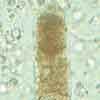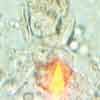- Clinical Technology
- Adult Immunization
- Hepatology
- Pediatric Immunization
- Screening
- Psychiatry
- Allergy
- Women's Health
- Cardiology
- Pediatrics
- Dermatology
- Endocrinology
- Pain Management
- Gastroenterology
- Infectious Disease
- Obesity Medicine
- Rheumatology
- Nephrology
- Neurology
- Pulmonology
Acute Glomerulonephritis in a Young Woman
A 26-year-old woman presented with a1-week history of pleuritic chest painand abdominal pain, which was associatedwith nausea but unrelated tofood intake or bowel movements. Shehad also had gross hematuria for thepast 10 days and swelling around hereyes and ankles as well as fatigue andarthralgias for 2 weeks.

A 26-year-old woman presented with a 1-week history of pleuritic chest pain and abdominal pain, which was associated with nausea but unrelated to food intake or bowel movements. She had also had gross hematuria for the past 10 days and swelling around her eyes and ankles as well as fatigue and arthralgias for 2 weeks.
She reported having "the flu" a month earlier. She denied injection drug use, cough, and sinus complaints. Her 3 young children had an upper respiratory tract illness at about the same time as her flu-like symptoms last month. She took no long-term medications.
Examination. The patient appeared tired but was in no acute distress. Temperature was 36.9ºC (98.4ºF); heart rate, 60 beats per minute; respiration rate, 20 breaths per minute; blood pressure, 132/76 mm Hg; and oxygen saturation measured by pulse oximetry was 100% while breathing ambient air. Mild periorbital edema was noted. Chest pain was reproducible by palpation and by deep inspiration. Bowel sounds were present. Abdomen was diffusely tender without rebound tenderness or guarding. There was edema of the lower extremities to mid-tibia. Arthralgias without arthritis were noted in the hands.
Laboratory studies. Complete blood cell count revealed normocytic, normochromic anemia and thrombocytosis. Other laboratory values included an erythrocyte sedimentation rate of 142 mm/h; blood urea nitrogen, 31 mg/dL; serum creatinine, 1.3 mg/dL (baseline level was unknown); and serum albumin, 1.9 g/dL. Blood cultures were negative. Urinalysis showed a large amount of blood, 100 mg/dL of protein, and 10 to 12 white blood cells and 35 to 40 red blood cells per high-power field. C3 complement level was 6 mg/dL (normal, 59 to 120 mg/dL). Chest radiographic findings were normal.
Results of a urinary sediment examination revealed red blood cell casts-a pathognomonic finding for acute glomerulonephritis (Figure). The antistreptolysin O (ASO) titer was 1590 units/mL (normal, 0 to 117 units/mL).
ACUTE GLOMERULONEPHRITIS: AN OVERVIEW
Glomerular hematuria may herald acute renal failure. This patient's urinary sediment with red cell casts as well as her proteinuria, edema, and hypocomplementemia were all signs of nephritis and prompted further evaluation.
The differential diagnosis of acute glomerulonephritis includes conditions that are associated with low complement levels (poststreptococcal glomerulonephritis, endocarditis, lupus nephritis, and cryoglobulinemia) and those that are not (Henoch-Schönlein purpura, IgA nephropathy, Goodpasture syndrome, and Wegener granulomatosis). This patient's elevated ASO titer (present in 50% to 70% of cases),1 active urinary sediment, and hypocomplementemia confirmed the diagnosis of poststreptococcal glomerulonephritis.
Typically a disease of children, poststreptococcal glomerulonephritis is caused by antibodies to unknown antigens of type 12 group A b-hemolytic streptococci. Symptoms develop 1 to 4 weeks after streptococcal infection of the pharynx or skin. Hematuria associated with poststreptococcal glomerulonephritis should be distinguished from hematuria that develops within 1 day of upper respiratory tract symptoms in patients with IgA nephropathy; in the latter setting, hematuria frequently recurs.

Poststreptococcal glomerulonephritis is typically self-limited. Ninety-five percent of children recover spontaneously. Progression to chronic renal failure occurs in up to 20% of adults.2 In adults who recover spontaneously, the elevated creatinine level returns to baseline within 4 weeks and complement levels normalize within 8 weeks. Hematuria usually resolves within 6 months, whereas proteinuria may persist for 3 years.
OUTCOME OF THIS CASE
In retrospect, the patient's flu-like illness 1 month earlier was probably her initial streptococcal infection. She was given amoxicillin for 14 days to eradicate any remaining infection. The arthralgias and chest pains resolved 2 days into therapy, and blood urea nitrogen and creatinine levels decreased to 16 and 0.9 mg/dL, respectively, by the time of discharge on day 3. Her blood pressure, hematuria, proteinuria, and serum creatinine and complement levels will be closely monitored for any indication of hypertension or renal damage.
References:
REFERENCES:1. Berrios X, Lagomarsino E, Solar E, et al. Post-streptococcal acute glomerulonephritis in Chile-20 years of experience. Pediatr Nephrol. 2004;19: 306-312.
2. Pinto SW, Sesso R, Vasconcelos E, et al. Follow-up of patients with epidemic poststreptococcal glomerulonephritis. Am J Kidney Dis. 2001;38:248-255.
